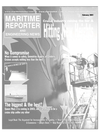
Transas Expands Capabilities
Relying on experience from more than 4,000 Navi-Sailor installations around the world, Transas Marine has added a number of features to further enhance the functionality of its Navi-Sailor marine navigation systems. Transas' ongoing R&D efforts are primarily focused on expanded integration with other systems, in providing a wider range of data which can be displayed on the electronic chart screen; and development and improvement of chart plotting features and presentation.
Current efforts include: Integration with VDR Seamless integration between navigational software and VDR provides for instantaneous display of all vessel parameters during the entire sailing duration.
After the voyage, the information can provide exhaustive data. Such data is proving increasingly valuable for accident investigations, or for analysis by ship operators, who are able to assess the behavior of their ships with greater confidence than ever before.
Integration with AIS (Automated Information System) As of 2002, all ships of 300 gt and over will be required to carry a transponder.
ECS and ECDIS are certainly the most effective platforms to display the transponder information, to be viewed by the navigator. The use of transponder information in combination with radar and ARPA information is especially efficient on an electronic chart background, when all functions and advantages of this equipment can be properly implemented.
For ships, which are for example engaged in patrol or surveillance operations, the use of transponders provides a highly effective method of target identification.
An automated comparison with the database available on board allows instantaneous discrimination between a friendly or hostile target, between ships holding a fishing license and those without for instance.
Radar Overlay Transas has designed a new version of the dedicated Radar Integrator Board.
Interfaced with any existing radar, the Radar Integrator converts the radar's video signal to digital form, which allows a radar picture to be overlaid onto an electronic chart. The Radar Integrator Board starts processing and tracking the target, as well as recording its parameters onto a computer hard disk from the moment the target appears within the radar operating range. Even if the target is beyond the reach of the screen display, the related information is gathered and processed in the same way as when a target is displayed on screen. If the target should become dangerous, CPA and TCPA alarms are generated. Whenever the operator needs data on any of the targets, it is immediately available without the several minutes delay required for the data processing, which is currently the case with ARPA's.
Display of Weather Information The facility for automated display of weather information on the Navi-Sailor screen, is another significant development on the way to the establishment of a oneman bridge. Unlike other existing weather forecast packages, five-day animated forecasts sourced from the U.K. Meteorological Office can be displayed over the electronic chart, which is an extremely useful tool for proper passage planning.
The integration of weather information on the electronic chart helps determine the weather effect on vessel voyage times and fuel consumption, and allows the navigator to avoid dangerous weather conditions.
Monitored parameters include pressure, wind speed and direction, as well as a variety of sea state conditions. Delivery of forecasts is completely under control of the user, who can receive the data via email from ship or shore.
Incorporation of Navtex Information Transas has been able to connect a Navtex receiver to an ECDIS. The dedicated software which is automatically connected, reads off messages arriving via Navtex, extracts the co-ordinates, area, transmission station, topic and other parameters, saves the message onto the hard disk and displays the message mark on the electronic chart. Implementation of the Navtex interface with a navigational system is a further significant step towards automated chart updating service.
Circle 199 on Reader Service Card
Other stories from February 2001 issue
Content
- Plug & Play page: 36B
- Uniservice: Innovative Product Keeps Cruise Ships Running page: 36C
- Transas Expands Capabilities page: 36G
- Kvaerner Conducts Sea Trials; Docks Out New Cruise Vessels page: 36A
- Drew Offers Electronic Steam System Monitoring page: 36H
- Crystal Cruises Signs Contract For New Ship page: 5
- Mediterranean Shipping Orders New Cruise Ship page: 5
- Two-Stroke Milestones page: 8
- Dear President Bush... Reasons for More Title XI Funding page: 11
- Real Time, On-line Credit Services Offered page: 14
- Major Ocean Carriers Partner To Launch E-Commerce Solution page: 15
- San Francisco Bay Area Company Leads in NOX Reduction page: 16
- Alabama Shipyard Signs Another Tug/Barge Contract page: 17
- Bollinger To Construct Supply Boat Trio page: 19
- Curacao Carves A Cruise Niche page: 20
- U.S. Lines' MS Patriot Challenges Cascade General page: 21
- Royal Caribbean Stock Downgraded page: 25
- ! Safe Haven1 Debate Could Have Resounding Effects page: 27
- ABS Under Fire, Fights Back page: 29
- Queen Mary 2: Cunard's Answer to Royalty on the Seas page: 30
- Kaparis Defines Safety on Cruise Ships page: 32
- The Dickinson Way page: 34
- Oceancell by GEOLINK: The First GSM Solution Via Satellite Aboard Ships page: 40
- Heroes on the High Seas page: 43
- MAVCO Onboard Explorer Of The Seas page: 49
- New Cat-Powered Tugboat Ordered As Gdansk Gears Up For Port Growth page: 58
- ARCOMS Appoints President For Subsidiary page: 61
- Grat Cruise Ships of 2000 page: 71
- The Cradle of Cruising Creativity? page: 72

